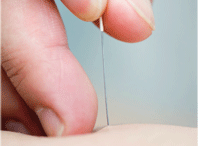Acupuncture, a traditional Eastern therapy, is considered non-traditional medicine in the Western world. But could it become a mainstay in amblyopia treatment? According to the findings of a single-center randomized study of more than 80 children with lazy eye—it could.

Acupuncture could be more effective than patching for the treatment of amblyopia.
Dennis Lam, M.D., of the Chinese University of Hong Kong, and colleagues found that visual acuity of amblyopic children age seven to 12 treated with acupuncture (five weekly sessions) improved more significantly than of those who wore an eye patch for two hours each day.
Throughout the 25-week study, subjects received optical correction and were challenged with an hour of near-vision tasks every day. At 15 weeks, visual acuity of the lazy eye improved 2.27 lines in the acupuncture group and 1.83 lines in the eye-patching group. The resolution rate was 41.5% in the acupuncture group and 16.7% in the patching group, but by 25 weeks, amblyopia was resolved in 30% of patching patients and 42.1% of acupuncture patients.
These numbers suggest that acupuncture is beneficial in the treatment of amblyopia in children. However, optometrist Darin Strako, director of pediatrics at North Suburban Vision Consultants, in Deerfield, Ill., says that further research is necessary.
So if you can convince your pediatric patients to undergo acupuncture therapy instead of wearing a patch, how should you go about recommending an acupuncturist? “Finding an acupuncturist would be like finding a referring M.D.,” says Dr. Strako. “Someone you trust and someone who has experience in the specialty that you need.”
Occlusion therapy through eye patching effectively improves lazy eye, but it’s often associated with reduced patient compliance due to the stigma that stems from wearing a patch, the study researchers wrote. If proven to work just as well, acupuncture may serve as a viable option in amblyopia correction.
Zhao J, Lam DS, Chen LJ, et al. Randomized controlled trial of patching vs acupuncture for anisometropic amblyopia in children aged 7 to 12 years. Arch Ophthalmol. 2010 Dec;128(12):1510-7.

